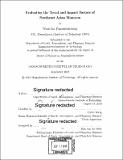| dc.contributor.advisor | Chien Wang. | en_US |
| dc.contributor.author | Panasawatwong, Warittha | en_US |
| dc.contributor.other | Massachusetts Institute of Technology. Department of Earth, Atmospheric, and Planetary Sciences. | en_US |
| dc.coverage.spatial | as----- | en_US |
| dc.date.accessioned | 2019-01-11T16:08:11Z | |
| dc.date.available | 2019-01-11T16:08:11Z | |
| dc.date.copyright | 2018 | en_US |
| dc.date.issued | 2018 | en_US |
| dc.identifier.uri | http://hdl.handle.net/1721.1/119993 | |
| dc.description | Thesis: S.M. in Atmospheric science, Massachusetts Institute of Technology, Department of Earth, Atmospheric, and Planetary Sciences, 2018. | en_US |
| dc.description | Cataloged from PDF version of thesis. | en_US |
| dc.description | Includes bibliographical references (pages 51-53). | en_US |
| dc.description.abstract | As a global leading agricultural producer, Southeast Asian (SEA) economy and livelihood rely on water supply from the monsoon precipitation during the rainy season. However, SEA monsoon system is still understudied. Here, we focus on the Mainland SEA monsoon because of its geographical simplicity. We find that the total precipitation of the Mainland SEA monsoon has experienced a reversing trend from a four-decade-long drying by 0.18 mm day-1 decade-1 to increasing by 0.13 day-1 decade-1 starting from 1989. The increased energy and moisture post-reversal comes from the strengthened Hadley and Walker cell due to the increasing meridional equivalent potential temperature ([theta]e) gradient. The meridional [theta]e gradient shows significant correlation with the precipitation time-series at r = 0.52 (p = 0.0015), despite [theta]e gradient has reversed ahead of precipitation for 4-5 years. Even though the overall precipitation trend of Mainland SEA in recent decades is increasing, the north of Myanmar and the south of China shows a decreasing trend. The surface wind analysis shows that surface southwesterly is weakening in the Northern Hemisphere, so the north of Mainland SEA receives less moisture, but also allow more moisture from the South China Sea to access the south of Mainland SEA. The surface wind change also corresponds with the rising branch of Hadley cell shifting southward. Lastly, we find that the Mainland SEA monsoon is a mixed convection system, composing of deep, moist convection directly over the region at 10-20°N, and a shallow, dry convection just north of the region at 35°, aligning with further assessment using zonal-mean precipitation, [theta], and [theta]e,. The deep, moist convection coincides with the zonal-mean [theta]e peak. The shallow, dry convection coincides with the zonal-mean [theta] peak. | en_US |
| dc.description.statementofresponsibility | by Warittha Panasawatwong. | en_US |
| dc.format.extent | 53 pages | en_US |
| dc.language.iso | eng | en_US |
| dc.publisher | Massachusetts Institute of Technology | en_US |
| dc.rights | MIT theses are protected by copyright. They may be viewed, downloaded, or printed from this source but further reproduction or distribution in any format is prohibited without written permission. | en_US |
| dc.rights.uri | http://dspace.mit.edu/handle/1721.1/7582 | en_US |
| dc.subject | Earth, Atmospheric, and Planetary Sciences. | en_US |
| dc.title | Evaluating the trend and impact factors of Southeast Asian monsoon | en_US |
| dc.type | Thesis | en_US |
| dc.description.degree | S.M. in Atmospheric science | en_US |
| dc.contributor.department | Massachusetts Institute of Technology. Department of Earth, Atmospheric, and Planetary Sciences | |
| dc.identifier.oclc | 1080939358 | en_US |
